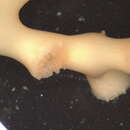en
names in breadcrumbs


"Madrepora oculata Linnaeus, 1758, p. 798.—von Marenzeller, 1904b, p. 79.—Eguchi, 1968, p. C-29, pi. C-8, figs. 1-9.—Zibrowius, 1974a, pp. 762- 766, pi. 2, figs. 2-5; 1980, pp. 36-40, pi. 13, figs. A-P.—Cairns, 1979, pp. 39-42, pi. 3, fig. 2, pi. 4, fig. 5, pi. 5, figs. 1-3.
Amphihelia oculata; Milne Edwards and Haime, 1857, p. 119.—von Marenzeller, 1904a, p. 308, pi. 14, figs. 1, lb.
Amphihelia ramea; Duncan, 1873, p. 326, pi. 44, figs. 1-3, pi. 45, figs. 4-6, pi. 46, figs. 1-19.
Lophohelia candida Moseley, 1881, pp. 179, 180, pi. 9, figs. 6-13.
? Madrepora vitiae Squires and Keyes, 1967, p. 22, pi. 1, figs. 4-8.
Description. Colony bushy or flabellate, formed by extratentacular budding. End branches having sympodial arrangement of corallites, measuring between 2.3 and 4.0 mm in diameter; diameter of attached base up to 2 cm. Calices round, 2.4-3.8 mm in diameter, exsert on end branches, recessed or flush with coenosteum toward base. Coenosteum smooth, extremely finely granulated; costae and coenosteal striae rare. Septa hexamerally arranged in three cycles. Sl equal to or larger than S2; S3 much smaller, sometimes rudimentary. Inner edges of septa straight, sometimes thickened near columella. Septal faces covered by granules, sometimes twice as high as septal thickness. Fossa variable in depth, usually dependent on age of corallite, older corallites having shallower fossae. Columella variable, usually papillose, sometimes absent.
Discussion. More complete synonymies and descriptions are given by Zibrowius (1974a, 1980) and Cairns (1979). Zibrowius (1974a) lists the nominal species of Madrepora and discusses their relationship to M. oculata. Madrepora oculata is a widespread and extremely variable species. Characters that are subject to variation, sometimes within the same colony, include frequency of branching, intercorallite distance, coenosteum texture and color, relative septal sizes, septal granulation, fossa depth, and development of columella. A closely related, if not identical, species, M. vitiae Squires and Keyes, 1967, was also collected off New Zealand (Eltanin stations 1814, 1816, and 1818; NZOI station C-642) (Map 2). The only difference between the two is that M. vitiae usually has paliform lobes, sometimes quite thick, before the S2. However, a branch of a topotypic specimen of M. vitiae has corallites with and without pali, and some calices have a variable number of paliform lobes (1-6). The T-shaped inner septal edges mentioned by Squires and Keyes (1967) were not observed in specimens collected from the typelocality (NZOI station B-314) or in specimens from five other lots near the type-locality. They may have been referring to the slight thickening of the inner septal edges, which is common in M. oculata. Zibrowius's (1974a) M. oculata from off lie Saint-Paul, Indian Ocean, is similar to M. vitiae; however, he did not consider the presence of P2 as a specific difference. If the presence or absence of P2 is considered to be of no specific value, then M. vitiae may be dropped to a form.
Material. Eltanin sta. 254, USNM 47500; sta. 1346, USNM 47499; sta. 1403, USNM. 47501; sta. 1416, USNM 47665; sta. 1422, USNM 47497; sta. 1814, USNM 47502; sta. 1816, USNM 47498; sta. 1818, USNM 47504. NZOI sta. C-642, USNM 47514; sta. D-6, USNM 47503. Specimens listed by Cairns (1979), USNM; topotypic specimens of M. vitiae from NZOI sta. B-314, type lot, USNM 47515. Syntypes of L. candida.
Types. The types of M. oculata are lost. Typelocality: off Sicily and Tyrrhenian Sea, Mediterranean. Syntypes of L. candida are deposited at the British Museum (1880.11.25.95). Type-locality: off Sombrero island, Lesser Antilles; 823 m. The holotype of M. vitiae is deposited at the New Zealand Oceanographic Institute (17). Typelocality: off Cape Farewell, New Zealand; 230-251 m.
Distribution. According to Zibrowius (1974a, p. 776), distribution of M. oculata worldwide outside of polar seas. Three of above-mentioned records extend the southernmost distribution of M. oculata to Subantarctic waters: Hjort Seamount, a seamount in the Subantarctic South Pacific, and a seamount in the Drake Passage (Map 2). Worldwide depth range: 80-1500 m; Subantarctic records: 549-833 m." Cairns, 1982 p. 15, Plate 3, figs. 4-6.